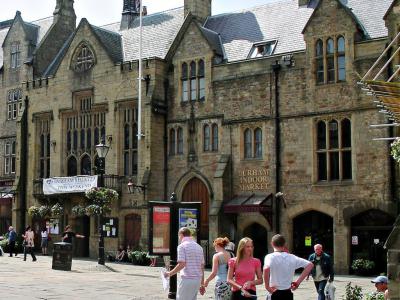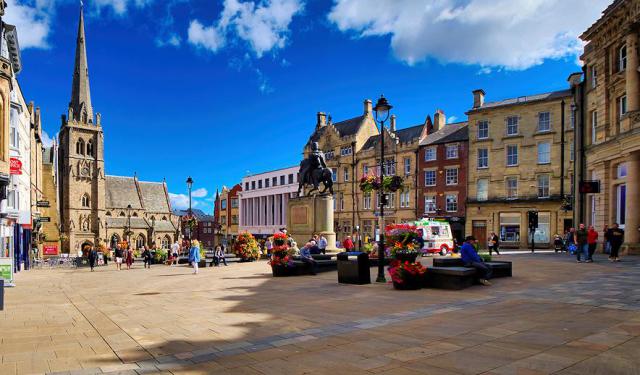Durham Market Hall, Durham
Just off Durham’s Market Place, Durham Market Hall keeps things buzzing under its Victorian iron-and-glass canopy. A short stroll from the Cathedral and Castle, it trades cobblestones for chatter, fresh coffee, and the kind of local advice you won’t get from a brochure. It’s less “historic monument,” more “living, breathing snack-and-souvenir generator.”
Inside, it’s equal parts food haven and treasure hunt. One aisle might tempt you with bread still warm from the oven, while the next offers vintage records, hand-knit socks, or jars of local chutney that somehow end up in your bag. Butchers and bakers hold down the classics, while indie makers, booksellers, and florists keep things fresh. It’s ideal for piecing together a riverside picnic, grabbing a quirky souvenir, or scoring a hot lunch that won’t cost more than your bus fare.
Entry’s straight from the Market Place, and the vibe is as unfussy as the prices. It’s dry in winter, cool in summer, stroller- and grandparent-friendly, and just chaotic enough to be fun. Mornings offer the widest selection, and if you’ve got a reusable bag handy, all the better-produce here has a way of jumping in when you’re not looking. Most stalls take cards, but a couple of coins might score you a surprise treat.
Pair it with a look inside the Town Hall, a ramble along the River Wear, and the climb to Durham Cathedral, and you’ve just wrapped up a day that hits local, scenic, and snacky in under three hours.
Inside, it’s equal parts food haven and treasure hunt. One aisle might tempt you with bread still warm from the oven, while the next offers vintage records, hand-knit socks, or jars of local chutney that somehow end up in your bag. Butchers and bakers hold down the classics, while indie makers, booksellers, and florists keep things fresh. It’s ideal for piecing together a riverside picnic, grabbing a quirky souvenir, or scoring a hot lunch that won’t cost more than your bus fare.
Entry’s straight from the Market Place, and the vibe is as unfussy as the prices. It’s dry in winter, cool in summer, stroller- and grandparent-friendly, and just chaotic enough to be fun. Mornings offer the widest selection, and if you’ve got a reusable bag handy, all the better-produce here has a way of jumping in when you’re not looking. Most stalls take cards, but a couple of coins might score you a surprise treat.
Pair it with a look inside the Town Hall, a ramble along the River Wear, and the climb to Durham Cathedral, and you’ve just wrapped up a day that hits local, scenic, and snacky in under three hours.
Want to visit this sight? Check out these Self-Guided Walking Tours in Durham. Alternatively, you can download the mobile app "GPSmyCity: Walks in 1K+ Cities" from Apple App Store or Google Play Store. The app turns your mobile device to a personal tour guide and it works offline, so no data plan is needed when traveling abroad.
Durham Market Hall on Map
Sight Name: Durham Market Hall
Sight Location: Durham, England (See walking tours in Durham)
Sight Type: Shopping
Guide(s) Containing This Sight:
Sight Location: Durham, England (See walking tours in Durham)
Sight Type: Shopping
Guide(s) Containing This Sight:
Walking Tours in Durham, England
Create Your Own Walk in Durham
Creating your own self-guided walk in Durham is easy and fun. Choose the city attractions that you want to see and a walk route map will be created just for you. You can even set your hotel as the start point of the walk.
Durham Introduction Walking Tour
According to the legend, it all started with a missing cow. Back in 995, a group of monks fleeing Viking raiders were hauling around the remains of Saint Cuthbert when their saintly cargo decided to stop moving. No matter how hard they tried, the bier wouldn’t budge-until a milkmaid chasing her lost dun cow wandered past. ("Dun" is a dull shade of brownish grey. ) The monks took the... view more
Tour Duration: 2 Hour(s)
Travel Distance: 2.6 Km or 1.6 Miles
Tour Duration: 2 Hour(s)
Travel Distance: 2.6 Km or 1.6 Miles




